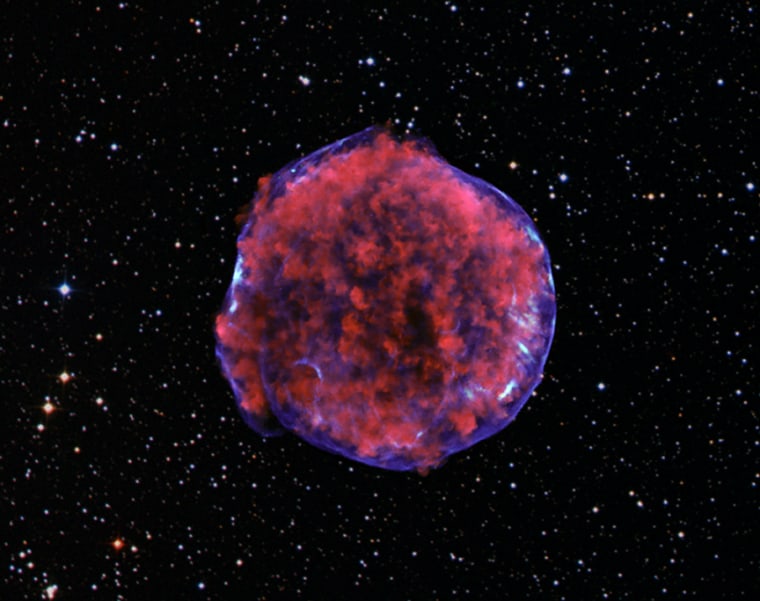
Scientists have discovered X-ray stripes in the remains of a supernova that may be the first direct evidence that these exploded stars can accelerate particles to energies a hundred times higher than those achieved with the Large Hadron Collider, the most powerful particle accelerator on Earth.
The striking 3-D-esque image of the Tycho supernova remnant was made from a long observation with NASA's Chandra X-ray Observatory. It could explain how some of the extremely energetic particles bombarding the Earth, called cosmic rays, are produced.
Since cosmic rays are composed of charged particles, like protons and electrons, their direction of motion changes when they encounter magnetic fields throughout the galaxy. As a result, the origin of individual cosmic rays detected on Earth cannot be determined, though supernova remnants have long been considered a good candidate for producing the most energetic cosmic rays in our galaxy.
The X-ray stripes observed in Tycho provide support for a theory about how magnetic fields can be dramatically amplified in supernova blast waves, producing cosmic rays. According to this theory, the magnetic fields become a tangled mess and the motions of the particles very turbulent near the expanding shock wave at the edge of the supernova. High energy charged particles can bounce back and forth across the shock wave repeatedly, gaining energy with each crossing.
Theoretical models of the motion of the most energetic particles — which are mostly protons — are predicted to leave a messy network of holes and dense walls corresponding to weak and strong regions of the magnetic field.

The X-ray stripes discovered by the Chandra researchers are thought to be regions where the turbulence is greater and the magnetic fields more tangled than surrounding areas, and may be the walls predicted by the theory. Electrons become trapped in these regions and emit X-rays as they spiral around the magnetic field.
That said, the regular and almost periodic pattern of the X-ray stripes (image at right) was not predicted by the theory and caught the researchers by surprise. "It could mean that the theory is incomplete, or that there's something else we don’t' understand," Jack Hughes, a professor of physics and astronomy at Rutgers University, said in a statement.
The size of the holes, or spacing, between the X-ray stripes is thought to correspond to the radius of the spiraling motion of the highest energy protons in the supernova remnant, the researchers say. If so, the spacing corresponds to energies about 100 times higher than reached in the Large Hadron Collider and equal the highest energies of cosmic rays thought to be produced in our galaxy.
The Tycho supernova remnant is named for the famous Danish astronomer Tycho Brahe, who reported observing the supernova in 1572. It is located in the Milky Way, about 13,000 light years from Earth. Because of its proximity and intrinsic brightness, the supernova was so bright that it could be seen during the daytime with the naked eye.
The results were published in the Feb. 20. 2011 issue of the Astrophysical Journal Letters.
More on cosmic rays:
- Leading theory about cosmic rays is shot down
- How deadly are cosmic rays?
- Source of super cosmic rays pinned down
- Galactic cosmic rays hit 50-year high
John Roach is a contributing writer for msnbc.com. Connect with the Cosmic Log community by hitting the "like" button on the Cosmic Log Facebook page or following msnbc.com's science editor, Alan Boyle, on Twitter (@b0yle).